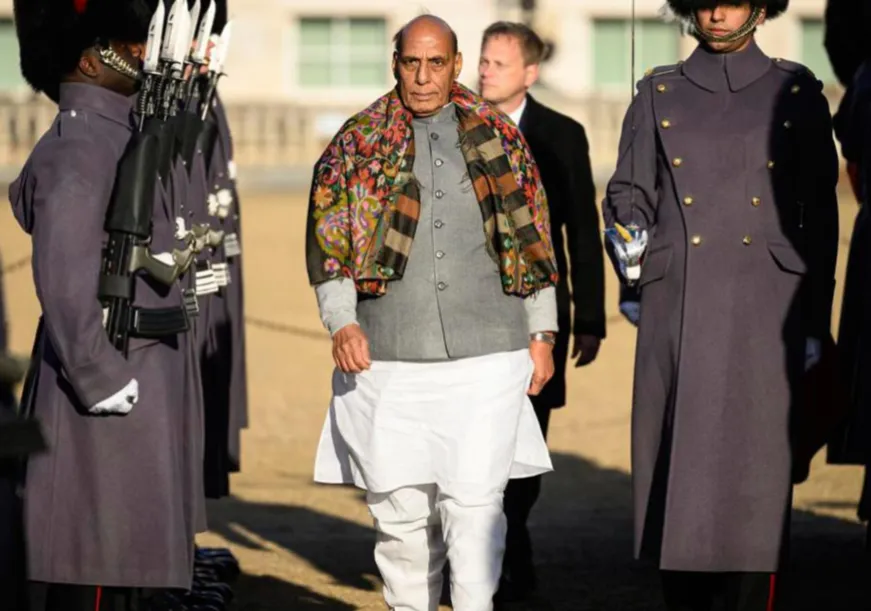Defence Minister Rajnath Singh’s recent visit to the United Kingdom (U.K.) came after a hiatus of 22 years. Opportunities have grown significantly in the last few years as opposed to two decades ago. The growth of Chinese military power and in particular its expansion into the Indian Ocean, which threatens India and also Sea Lines of Communications (SLOCs), on which the U.K. depends, have given the British an opportunity to reorient their strategic priorities.
The Indian Navy has several capability-related needs to make up for the shortfalls the service faces vis-à-vis the Peoples Liberation Army Navy (PLAN). Securing key technologies has been an integral part of Singh’s visit to the U.K. The U.K. is a in a position to help redress the Indian Navy’s technological gaps against the Chinese.
One key area where London and New Delhi are cementing cooperation is in electrical propulsion to power aircraft carriers. The India Navy’s carriers at present are not powered by electric propulsion technology. The Queen Elizabeth Class aircraft carriers of the Royal Navy (RN) use electric propulsion and the RN has mastered this technology.
The advantage of using electric propulsion is that warships integrated with this capability produce a low acoustic signature by removing the link between the principal mover and propulsion.
In the run-up to Singh’s visit, there were already preliminary engagements between the Indian and U.K. governments regarding the Indian Navy securing electric propulsion technology. Although, the PLAN for its part struggled to overcome the technical challenges associated electric propulsion, there is increasing yet anecdotal evidence emerging that the PLAN is in the process of integrating electric propulsion into its warships such as the Type 054B frigates.
The Indian Navy cannot sit idly and allow the Chinese navy to steal a march over a key piece of maritime technology for its advanced surface combatants in the future. The advantage of using electric propulsion is that warships integrated with this capability produce a low acoustic signature by removing the link between the principal mover and propulsion. There is also the added advantage of enhanced electrical power generation for subsystems in major warships of the Indian Navy’s surface fleet.
The establishment of a joint working group dubbed the “India-UK electric propulsion capability partnership” first met in February 2023 and thereafter a delegation level discussion was held on the Royal Navy frigate HMS Lancaster, which made a port visit to Kochi in March last year. Extensive discussion occurred the following month on the transfer of technical know-how and the Royal Navy’s experience in maritime electric propulsion for the Indian Navy’s major surface combatants in the future.
In November 2023, the India-U.K. electric propulsion capability partnership again met to discuss the possibility of the Indian Navy’s future warships to be integrated with electric propulsion technology. The British have agreed to train, equip and help establish infrastructure necessary to develop an electric propulsion system. Initially, the technology is expected to be tested on landing platforms docks and thereafter on surface vessels like guided missile destroyers belonging next generation with a displacement of over 6,000 tonnes.
The British have agreed to train, equip and help establish infrastructure necessary to develop an electric propulsion system.
While there are considerable opportunities in the India-U.K. defence relationship, challenges remain. A key challenge relates to legacy issues, especially in London’s effort to balance its ties between India and Pakistan. Successive U.K. governments have simultaneously supplied India and Pakistan with weapons or curbed weapons exports, leaving many in India frustrated with British motives and objectives in the Subcontinent.
Nettlesome issues surrounding Khalistan and Sikh separatism will also cloud the relationship. But today strategic realities have shifted with the emergence of the Peoples Republic of China (PRC) as a major naval power whose deployments in the Indian Ocean Region (IOR) are expanding rapidly, creating a very strong rationale for forging closer defence ties between the U.K. and India.
Several joint military exercises have already taken place between the two countries with deeper defence industrial cooperation on the anvil and during Singh’s visit, the British officially declared that they will be deploying a littoral response group, a specialised amphibious warfare group in 2024 and carrier strike group in 2025 to train and increase interoperability with the Indian Navy. With Rajnath Singh’s visit to the U.K., London is both rediscovering and bolstering its military involvement and presence East of Suez, which it had considerably until the late 1960s.
This commentary originally appeared in The Hindu.
The views expressed above belong to the author(s). ORF research and analyses now available on Telegram! Click here to access our curated content — blogs, longforms and interviews.




 PREV
PREV



